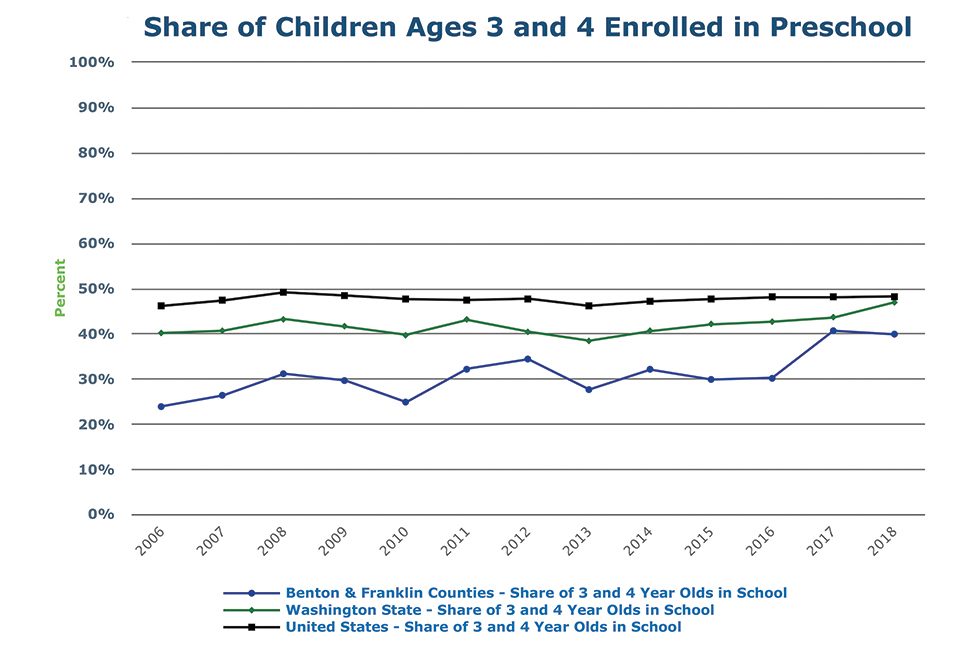
2020 wish list should include making progress on Tri-Cities’ early learning gap
By D. Patrick Jones
In this year-in-review issue, I’d like to look forward – far forward to the impacts of early childhood education in at least a couple decades. This is not the usual stuff of my columns, but the topic has significant implications for the future, including economic ones, of the greater Tri-Cities.
As
Benton-Franklin Trends data shows, the number of 3- and 4-year-olds enrolled in
Benton and Franklin counties’ preschools is lower than the rest of the state
and in the U.S, over the entire period measured. This is curious outcome for
the wealthiest metro area in Eastern Washington, as measured by median
household income. Specifically, the data measures the share of children ages 3
and 4 who are enrolled in preschool. The estimate for 2018 for the two counties
was 40 percent. In contrast, Washington state reported 47 percent while the
U.S. estimate was 48 percent.
The
data does bear some good news: rates of preschool attendance have gone up
substantially in the greater Tri-Cities since 2005. Cumulative growth in the
two counties since then has been 67 percent. Benton County has shown an
especially strong pulse, with the share of young children attending preschool
rising by 73 percent. Yet, Franklin County’s growth has been much, much lower,
at 15 percent. While it exceeds the improvement in the U.S., its pace is still
below that of the state.
Why
should we care? A moral response is straightforward. Most Americans still hold
the notion that we live in a land of opportunity, if not equal, then somewhat
equalized by access to quality education. This has been shared value for
decades, if not longer. Take away access to good schools and the common ground
we share becomes thinner.
We
know that preschool can be expensive. While we don’t enjoy data on average
costs for unsubsidized preschool in the two counties, we have access to a
“survival budget” in Washington for low-income families. Produced by United Way
of the Pacific Northwest as an alternative to the federal poverty threshold, it
lists the average statewide costs for child care in 2016 at nearly $1,300 a
month for two preschool children. This is clearly out of reach for low-income
families.
And
increasingly, school-age children are coming from lower-income families in the
greater Tri-Cities. A proxy for poverty among families with school-age children
is the count of students who qualify for free and reduced-price lunch. The
Trends data has created an indicator for this that shows over the past 20
years, the share (and count) has risen sharply. During the 1998-99 school year,
the share was 39 percent; for the 2018-19 school year, the share stood at 58
percent. This is a far higher percentage than the state average, and the gap
has widened over time.
Then
there’s the economic argument supplied by two very reputable sources: the
Minneapolis Federal Reserve Bank and Noble-prize winning economist James
Heckman.
In a
widely-cited work, two Minneapolis Federal Reserve researchers calculated the
internal rate of return of a preschool program in Ypsilanti, Michigan, that
began in the early 1960s. Data were available about young adult (up to age 27)
outcomes for the children who participated in the program as 3- and
4-year-olds. The researchers’ calculations put the societal return on
investment, compared to a control group, at about 12 percent per year, a very
high rate. Key elements to their calculations were: a substantial decrease in
the societal costs of crime and a substantial increase in the earnings.
Similarly,
Heckman’s statistical review of early childhood programs arrived at a 7 percent
to 10 percent return on investment for disadvantaged children enrolled in
preschool. Early childhood education, Heckman stated, narrows the well-known
achievement gap that begins in school and continues into adult earnings. The
benefits extend beyond earnings. In his review of longitudinal data of a North
Carolina preschool program, Heckman found health advantages, relative to a
control group. The incidence of costly chronic diseases such as hypertension,
heart disease, diabetes and obesity was considerably lower 30 years after a
preschool program.
According
to Heckman, the sooner preschool starts the better. “The highest rate of return
in early childhood development comes from investing as early as possible, from
birth through age 5, in disadvantaged families. Starting at age 3 or 4 is too
little too late, as it fails to recognize that skills beget skills in a
complementary and dynamic way. Efforts should focus on the first years for the
greatest efficiency and effectiveness. The best investment is in quality early
childhood development from birth to five for disadvantaged children and their
families.”
The
Tri-Cities certainly has its share of disadvantaged youth. An outcome measure
of preschool’s impact on a community is the WaKids Kindergarten Readiness
measure. The good news: the share of children in the school districts of the
two counties who meet standards in all six domains of kindergarten readiness
has doubled in the last seven years. The sobering news: that share, 39 percent,
is still several percentage points lower than the Washington average. A
substantial difference exists between the two counties and even more profound
gaps among the three large cities in the counties.
Is an
expansion of early learning opportunities in the greater Tri-Cities on the New
Year’s resolution list of area leaders for 2020? I hope so.
D. Patrick Jones is the executive director for Eastern Washington University’s Institute for Public Policy & Economic Analysis.
